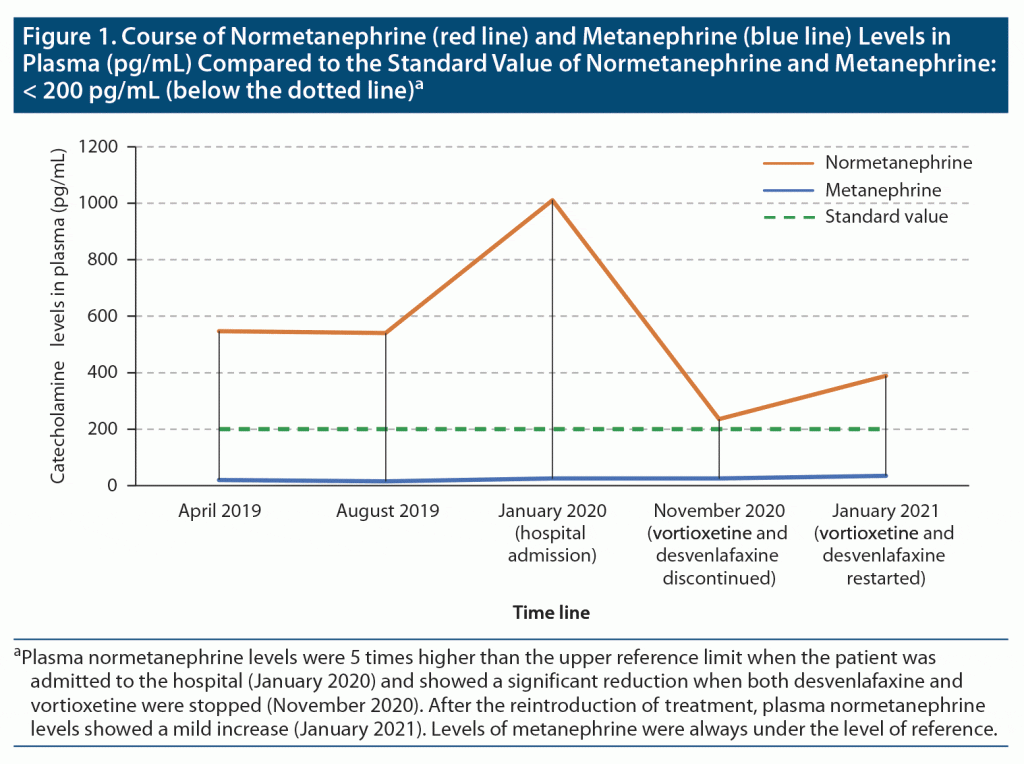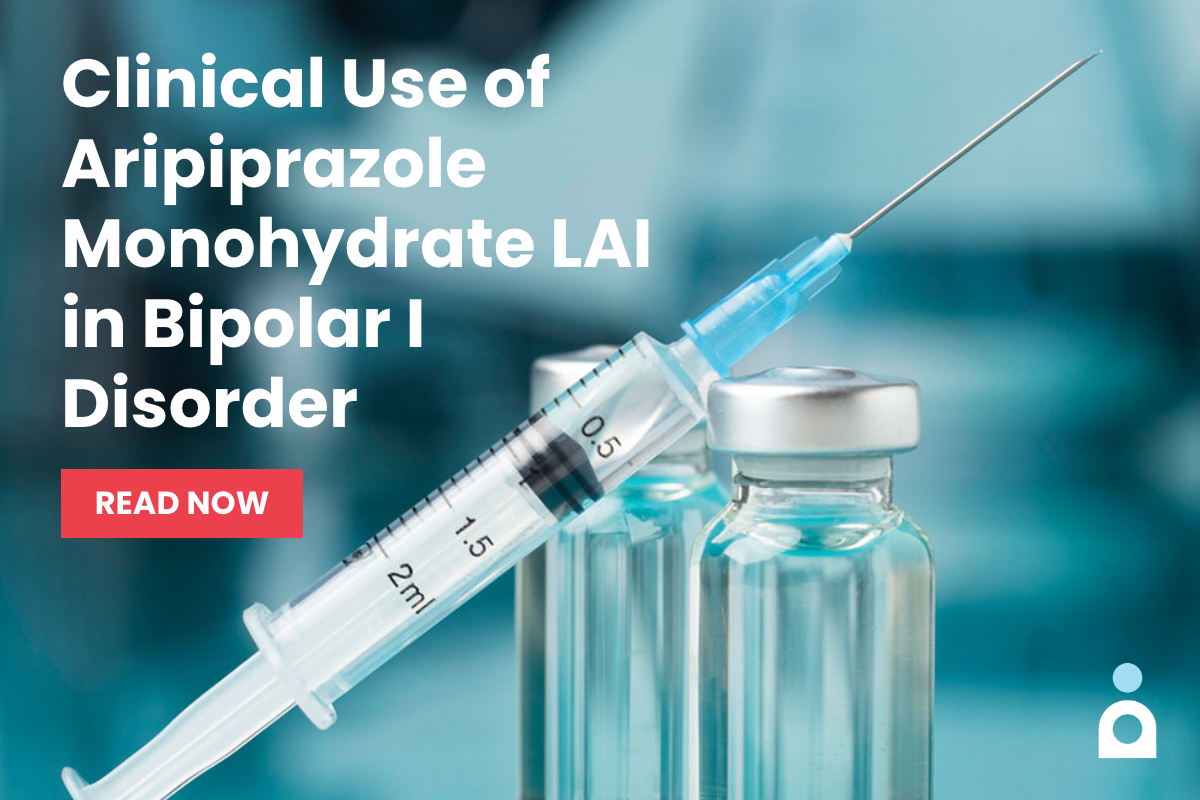
Prim Care Companion CNS Disord 2022;24(6):22cr03259
To cite: Stoppa A, Orois A. Antidepressant drug interaction in the diagnosis of an adrenal tumor. Prim Care Companion CNS Disord. 2022;24(6):22cr03259.
To share: https://doi.org/10.4088/PCC.22cr03259
© 2022 Physicians Postgraduate Press, Inc.
aMental Health Department, Consorci Sanitari de Terrassa, Terrassa, Barcelona, Spain
bDepartment of Endocrinology and Nutrition, Hospital Universitari Mútua de Terrassa, Terrassa, Barcelona, Spain
*Corresponding author: Aldo Stoppa, MD, Mental Health Department, Consorci Sanitari de Terrassa, Torrebonica St s/n, 08827, Terrassa, Barcelona, Spain ([email protected]).
Pheochromocytoma is a rare adrenal tumor that releases catecholamines and metanephrines. The measurement of free metanephrine levels in plasma is the best tool for its diagnosis, but some false-positive results have been described, most of them related to drug interaction. In this report, we describe the case of a woman hospitalized for adrenergic symptoms associated with antidepressants and a differential diagnosis of pheochromocytoma.
Case Report
A 74-year-old woman presented to our hospital with anxiety. Her medical conditions included dyslipidemia, arterial hypertension, and hypothyroidism, all well controlled with rosuvastatin, enalapril, amlodipine, and levothyroxine. Moreover, she was under endocrinologic follow-up because of a left adrenal tumor (12 x 10 mm), which was stable during the past few years, compatible with adenoma, and no evidence of hormonal production. She had also suffered from dysthymia and generalized anxiety disorder since the age of 25 years and had experienced 3 episodes of major depressive disorder.
Several antidepressants (ADs) were needed due to lack of remission, starting with an off-label combination of desvenlafaxine 150 mg plus vortioxetine 20 mg daily. She was stable for a year, but then began to suffer episodes of dyspnea and diaphoresis. As a result of poor outpatient control, she required hospitalization. Physical examination and complementary tests revealed high blood pressure (157/93 mm Hg), rhythmic tachycardia (137 bpm), and high plasma and urine normetanephrine levels (1,011 pg/mL [reference range, 0–196] and 613 µg/24 h [reference range, 0–444], respectively). Plasma and urine metanephrine levels, however, were within normal limits, as well as vanillylmandelic acid and dopamine levels. The endocrinologists suggested stopping desvenlafaxine and vortioxetine treatment. After 10 days without ADs, the patient’s adrenergic symptoms disappeared. In parallel, plasma normetanephrine levels returned to nearly normal levels (235 pg/mL [reference range, 0–196]).
As her depressive symptoms worsened a few months after discharge, treatment with desvenlafaxine 50 mg/d and vortioxetine 10 mg/d was resumed, achieving clinical and biochemical stabilization for at least 6 months, with a mild increase in normetanephrine levels to 389 pg/mL (reference range, 0–196). Figure 1 provides the patient’s course of plasma normetanephrine and metanephrine levels compared to standard values.
Discussion
Pheochromocytoma causes sympathetic nervous system hyperactivity due to a release of catecholamines, and symptoms may include diaphoresis and anxiety. High levels of free metanephrines in plasma is the gold standard for pheochromocytoma diagnosis, but false positives may be caused by various medications.1,2 Some of these drugs, such as selective serotonin reuptake inhibitors and serotonin-norepinephrine reuptake inhibitors (SNRIs), have been associated with an increase in normetanephrine but not metanephrine.3
Diaphoresis is a dose-related side effect related to SNRIs in up to 10% of cases.4 Other cardiovascular side effects are mostly associated with SNRIs and can be explained by an interaction of noradrenergic and serotonergic mechanisms.5
Our hypothesis is that desvenlafaxine, and to a lesser extent vortioxetine, is the cause of elevated normetanephrine levels, which correlates with the symptoms. The patient’s symptoms began with no apparent cause after receiving the same dosage of ADs for about 1 year. However, shortly after the dosage was lowered the symptoms stopped, suggesting a dose-related adverse effect. Although the initial trigger is unknown, we must take into account that in a geriatric patient, any slight change (eg, dehydration) may contribute to a breakdown of homeostasis. A mild form of serotonin syndrome was considered but rejected due to lack of neuromuscular symptoms. Other diagnoses such as an allergic reaction were ruled out based on clinical manifestations.
Conclusions
An off-label combination of desvenlafaxine and vortioxetine may be an effective tool for controlling severe and resistant depressive symptoms. Nevertheless, we must be aware of serious adverse effects, especially in older patients. These ADs could involve hyperactivation of the sympathetic nervous system, presenting with anxiety, hypertension, or hyperhidrosis, and simultaneously cause false positives in pheochromocytoma screening with a challenging differential diagnosis.
Published online: December 27, 2022.
Relevant financial relationships: None.
Funding/support: None.
Patient consent: The patient provided written consent to publish the case report, and information has been de-identified to protect anonymity.
References (5)

- Eisenhofer G, Goldstein DS, Walther MM, et al. Biochemical diagnosis of pheochromocytoma: how to distinguish true- from false-positive test results. J Clin Endocrinol Metab. 2003;88(6):2656–2666. PubMed CrossRef
- Neary NM, King KS, Pacak K. Drugs and pheochromocytoma: don’t be fooled by every elevated metanephrine. N Engl J Med. 2011;364(23):2268–2270. PubMed CrossRef
- Mañas-Martínez AB, Aragoneses-Calvo A, Matei A, et al. Venlafaxine drug interaction in the diagnosis of pheochromocytoma. Endocrinol Nutr. 2016;63(10):569–570. PubMed CrossRef
- Yang LPH, Plosker GL. Desvenlafaxine extended release. CNS Drugs. 2008;22(12):1061–1069. PubMed CrossRef
- Demling J, Beyer S, Kornhuber J. To sweat or not to sweat? A hypothesis on the effects of venlafaxine and SSRIs. Med Hypotheses. 2010;74(1):155–157. PubMed CrossRef
Please sign in or purchase this PDF for $40.


